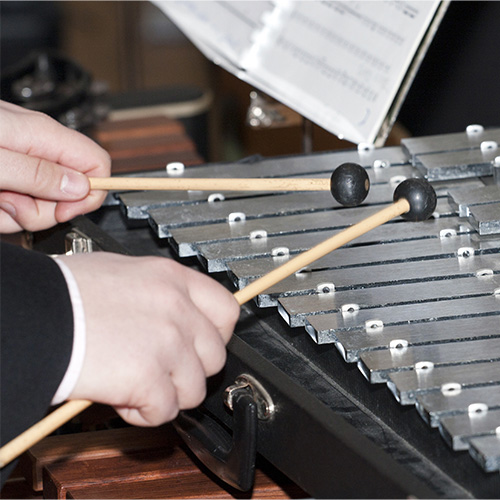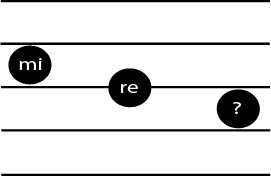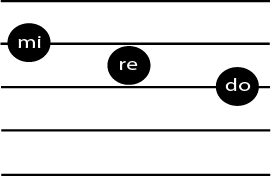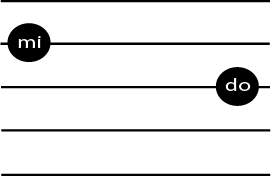Y2. Lesson 8. Trichord mi-re-do
Prior learning: re
Duration: 30 minutes
Materials:
Keywords: Beat, rhythm, singing, chanting, partners, rhymes, circle games.
Difficulty: ![]()
Prepare
Present
Trichord mi-re-do
Practise
re
 Melodic development
Melodic development
![]() Students discover other known songs containing the trichord mi-re-do.
Students discover other known songs containing the trichord mi-re-do.
- Begin by singing Hot Cross Buns and show hand signs.
- Students will repeat after you, singing and using hand signs.
- Ask students where mi-re-do is to be found [Hot Cross Buns].
- Project the graphic or draw the three notes on the staff for the target phrase.
- Sing Bow Wow Wow and repeat the process.
 Questions
Questions
- What are the last three notes of Hot Cross Buns? [mi-re-do]
- What are the last three notes of Bow Wow Wow? [mi-re-do]
- What are the last three notes of Buttercup? [mi-re-do]
- Each of those songs has a beat of silence at the end. What is that called? [za]
 Rhythmic development
Rhythmic development
![]() Students write the last phrase of Here Comes A Magpie in both stick and traditional notation.
Students write the last phrase of Here Comes A Magpie in both stick and traditional notation.


- Lead the class in singing Here Comes A Magpie.
- Ask students to sing and clap the rhythm of the song.
- Ask students to sing the time names of the last phrase after you.
- Choose a student to write the stick notation for the last phrase on the board. Repeat with other students.
- Choose a student to write the last phrase using stick notation.
- Repeat with as many students as possible, time permitting.
 Creative movement
Creative movement
![]() Students sing and clap to the beat in this circle game.
Students sing and clap to the beat in this circle game.
- Students form a circle with their arms raised as 'windows'.
- A student is chosen to be the 'magpie' and will weave in and out of the students 'windows'.
- Lead the class in singing the song.
- On the words "take a little partner", the 'magpie' chooses a partner and spins around with them, holding hands.
- The other students continue to sing and clap to the beat.
- At the song's end, the process is repeated with a new student as the 'magpie'.
 Listening
Listening
![]() Students listen and respond to intervals.
Students listen and respond to intervals.
- Students are seated and attentive.
- Explain that students will hear you sing two notes and tell you whether the interval is a skip or a step.
- Use a tuning fork or classroom instrument to set the pitch accurately.
- Begin by singing a so-mi interval. Students should copy you.
- If the first solfa note was so, what was the second note?
- Ask if there was a step or skip between them [skip].
- Sing other intervals and repeat the process to include intervals from the five-note pentatonic scale.
 Visual learning
Visual learning
![]() Students use visual cues and discover where mi-re-do can be found on an instrument.
Students use visual cues and discover where mi-re-do can be found on an instrument.
- If you have a piano in your classroom, play mi-re-do in the key of C [for simplicity].
- Explain that each of those notes moves by a step.
- Have a xylophone or glockenspiel ready on your desk and play mi-re-do.
 Instruments
Instruments
![]() Students practice a classroom song on tuned percussion.
Students practice a classroom song on tuned percussion.
- This arrangement is for two xylophones but can easily be adapted for glockenspiels or marimbas to take one of the parts if desired.
- Divide the class into two groups, each with an instrument.
- Teach the melody to the first group, demonstrating good mallet technique.
- When secure teach the accompaniment.
- Have both groups play together on your command and monitor students for timing and correct notes.
- This exercise may take more than one learning period.

 Part work
Part work
![]() Students sing a known pentatonic song in canon.
Students sing a known pentatonic song in canon.
- Divide the class into two groups.
- Explain that one group will sing Pumpkin Pumpkin, and the other will sing it in canon.
- Conduct the first group, having set the starting pitch.
- After one bar, lead the second group singing in canon.
- When secure, swap the two groups over and repeat.
Students section




 Assess
Assess
Suggested lessons
Y1. Beat II

Y1. Beat III

Y1. Beat IV

